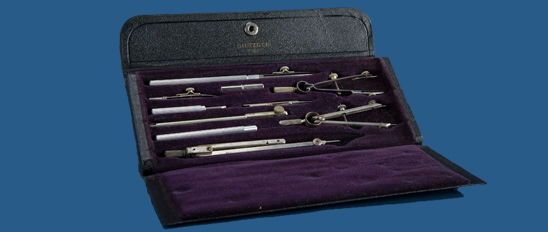This folding wood and cardboard case is covered with black leather and lined with green velvet. The back is marked: MADE IN GERMANY. Inside the top flap is the trademark for E. O. Richter & Co., which made drawing instruments in Chemnitz, Germany, from 1892 to the 1980s.
- Description
-
This folding wood and cardboard case is covered with black leather and lined with green velvet. The back is marked: MADE IN GERMANY. Inside the top flap is the trademark for E. O. Richter & Co., which made drawing instruments in Chemnitz, Germany, from 1892 to the 1980s. An ivory label inside the case is marked: KOLESCH & CO. (/) 138 FULTON ST. (/) NEW YORK. The set includes:
-
1) 2-1/2" German silver and steel screwdriver that contains three pencil leads.
-
2) 3-3/16" German silver pen handle containing four needle points.
-
3) 6-1/4" German silver dividers with lengthening bar and removable pencil, needle, and pen points. The center hinge is marked: Richter, followed by the Richter trademark.
-
4) 5-7/8" German silver fixed-leg dividers. The center hinge is marked: Richter, followed by the Richter trademark.
-
5) 5-1/2" and 5-1/8" wood, German silver, and steel drawing pens.
-
6) 3-1/2" steel bow pen, bow dividers, and bow pencil. The side of each instrument is marked: D.R.P. (Richter held German patents on several of its drawing instruments.) Below the mark is the Richter trademark. The bow pencil is also marked: Germany.
-
Richter sold this set, which appears to be complete and original, as model E1612. Kolesch & Company, which distributed the instruments, was a successor to the firm established in the early 19th century by Edmund M. Blunt and operated from 1885 to 1947. In 1917, it sold this set as model 1270R for $20.70. Compare to MA.325684, which appears to be a newer version of the set.
-
Holton Duncan Robinson (1863–1945) owned this set. He graduated from St. Lawrence University in 1886 and then worked for the civil engineering firm Buck and McNulty in New York City. He then worked on several New York bridges and consulted for the Canadian Northern Railway Company. He partnered with D. B. Steinman in 1920 and designed dozens of bridges in the United States, Canada, Bolivia, Brazil, Australia, Germany, Spain, and Denmark over the next twenty-five years.
-
References:
-
Catalogue of E. O. Richter & Co., 5th ed. (Chemnitz, Germany, [1926]), 71, 79; Charles E. Smart, The Makers of Surveying Instruments in America Since 1700 (Troy, N.Y.: Regal Art Press, 1962); Kolesch & Co., Illustrated Catalogue and Price-List, 11th ed. (New York, 1917), 50; D. B. Steinman, "Holton Duncan Robinson, M. ASCE," American Society of Civil Engineers Memoir 1571.
- Location
-
Currently not on view
- date made
-
1892-ca 1930
- maker
-
E. O. Richter & Co.
- ID Number
-
2007.0039.01
- accession number
-
2007.0039
- catalog number
-
2007.0039.01
